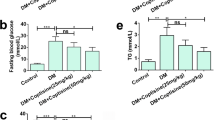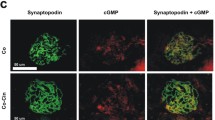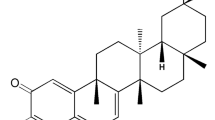Abstract
Diabetic nephropathy is the leading cause of end-stage renal failure and accounts for 30–40 % of patients entering renal transplant programmes. The nephroprotective effects of the neuropeptide pituitary adenylate cyclase-activating polypeptide (PACAP38) against diabetes have been shown previously, but the molecular mechanisms responsible for these effects remain unknown. In the present study, we showed that PACAP treatment counteracted the diabetes-induced increase in the level of the proapoptotic pp38MAPK and cleaved caspase-3 and also decreased the p60 subunit of NFκB. The examined antiapoptotic factors, including pAkt and pERK1/2, showed a slight increase in the diabetic kidneys, while PACAP treatment resulted in a notable elevation of these proteins. PCR and Western blot revealed the downregulation of fibrotic markers, like collagen IV and TGF-β1 in the kidney. PACAP treatment resulted in increased expression of the antioxidant glutathione. We conclude that the nephroprotective effect of PACAP in diabetes is, at least partly, due to its antiapoptotic, antifibrotic and antioxidative effect in addition to the previously described antiinflammatory effect.





Similar content being viewed by others

References
Aoki M, Nata T, Morishita R et al (2011) Endothelial apoptosis induced by oxidative stress through activation of NF-kappaB: antiapoptotic effect of antioxidant agents on endothelial cells. Hypertension 38:48–55
Araki N, Takagi K (1992) Relaxant effect of pituitary adenylate cyclase-activating polypeptide on guinea-pig tracheal smooth muscle. Eur J Pharmacol 216:113–117
Arimura A, Li M, Batuman V (2006) Potential protective action of pituitary adenylate cyclase-activating polypeptide (PACAP38) on in vitro and in vivo models of myeloma kidney injury. Blood 107:661–668
Banki E, Degrell P, Kiss P et al (2013) Effect of PACAP treatment on kidney morphology and cytokine expression in rat diabetic nephropathy. Peptides 42:125–130
Banks WA, Kastin AJ, Komaki G, Arimura A (1993) Passage of pituitary adenylate cyclase activating polypeptide1-27 and pituitary adenylate cyclase activating polypeptide1-38 across the blood–brain barrier. J Pharmacol Exp Ther 267:690–696
Bourgault S, Vaudry D, Botia B et al (2008) Novel stable PACAP analogs with potent activity towards the PAC1 receptor. Peptides 29:919–932
Chen L, Zhang J, Zhang Y, Wang Y, Wang B (2008) Improvement of inflammatory responses associated with NF-kappa B pathway in kidneys from diabetic rats. Inflamm Res 57:199–204
Davis W Jr, Ronai Z, Tew KD (2001) Cellular thiols and reactive oxygen species in drug-induced apoptosis. J Pharmacol Exp Ther 296:1–6
Delgado M, Ganea D (2001) Inhibition of endotoxin-induced macrophage chemokine production by VIP and PACAP in vitro and in vivo. Arch Physiol Biochem 109:377–382
Delgado M, Jonakait GM, Ganea D (2002) Vasoactive intestinal peptide and pituitary adenylate cyclase-activating polypeptide inhibit chemokine production in activated microglia. Glia 39:148–161
Di Mario U, Pugliese G (2001) 15th Golgi lecture: from hyperglycaemia to the dysregulation of vascular remodelling in diabetes. Diabetologia 44:674–692
Di Paolo S, Gesualdo L, Ranieri E, Grandaliano G, Schena FP (1996) High glucose concentration induces the overexpression of transforming growth factor-beta through the activation of a platelet-derived growth factor loop in human mesangial cells. Am J Pathol 149:2095–2106
Ferencz A, Kiss P, Weber G et al (2010a) Comparison of intestinal warm ischemic injury in PACAP knockout and wild-type mice. J Mol Neurosci 42:435–442
Ferencz A, Weber G, Helyes Z, Hashimoto H, Baba A, Reglodi D (2010b) Presence of endogenous PACAP-38 ameliorated intestinal cold preservation tissue injury. J Mol Neurosci 42:428–434
Filipsson K, Pacini G, Scheurink AJ, Ahren B (1998) PACAP stimulates insulin secretion but inhibits insulin sensitivity in mice. Am J Physiol 274:834–842
Ganea D, Delgado M (2003) The neuropeptides VIP/PACAP and T cells: inhibitors or activators? Curr Pharm Des 9:997–1004
Gilbert RE, Cox A, Wu LL et al (1998) Expression of transforming growth factor-beta1 and type IV collagen in the renal tubulointerstitium in experimental diabetes: effects of ACE inhibition. Diabetes 47:414–422
Girard BM, Tompkins JD, Parsons RL, May V, Vizzard MA (2012) Effects of CYP-induced cystitis on PACAP/VIP and receptor expression in micturition pathways and bladder function in mice with overexpression of NGF in urothelium. J Mol Neurosci 48:730–743
Gnudi L (2012) Cellular and molecular mechanisms of diabetic glomerulopathy. Nephrol Dial Transplant 27:2642–2649
Gray SL, Cummings KJ, Jirik FR, Sherwood NM (2001) Targeted disruption of the pituitary adenylate cyclase-activating polypeptide gene results in early postnatal death associated with dysfunction of lipid and carbohydrate metabolism. Mol Endocrinol 15:1739–1747
Green BD, Irwin N, Cassidy RS, Gault VA, Flatt PR (2006) Long-term administration of PACAP receptor antagonist, PACAP(6-27), impairs glucose tolerance and insulin sensitivity in obese diabetic ob/ob mice. Peptides 27:2343–2349
Gui D, Guo Y, Wang F et al (2012) Astragaloside IV, a novel antioxidant, prevents glucose-induced podocyte apoptosis in vitro and in vivo. PLoS ONE 7:e39824
Ha H, Yu MR, Kim KH (1999) Melatonin and taurine reduce early glomerulopathy in diabetic rats. Free Radic Biol Med 26:944–950
Hills Paul E, Squires PE (2010) TGF-beta1-induced epithelial-to-mesenchymal transition and therapeutic intervention in diabetic nephropathy. Am J Nephrol 31:68–74
Horvath G, Brubel R, Kovacs K et al (2011) Effects of PACAP on oxidative stress-induced cell death in rat kidney and human hepatocyte cells. J Mol Neurosci 43:67–75
Iwamoto M, Mizuiri S, Arita M, Hemmi H (2005) Nuclear factor-κB activation in diabetic rat kidney: evidence for involvement of P-selectin in diabetic nephropathy. Tohoku J Exp Med 206:163–171
Kaneto H, Fujii J, Seo HG et al (1995) Apoptotic cell death triggered by nitric oxide in pancreatic beta-cells. Diabetes 44:733–738
Kelly DJ, Gilbert RE, Cox AJ, Soulis T, Jerums G, Cooper ME (2001) Aminoguanidine ameliorates overexpression of prosclerotic growth factors and collagen deposition in experimental diabetic nephropathy. J Am Soc Nephrol 12:2098–2107
Khan AM, Li M, Abdulnour-Nakhoul S, Maderdrut JL, Simon EE, Batuman V (2012) Delayed administration of pituitary adenylate cyclase-activating polypeptide 38 ameliorates renal ischemia/reperfusion injury in mice by modulating Toll-like receptors. Peptides 38:395–403
Klein R, Klein BE, Moss SE, Davis MD, DeMets DL (1984) The Wisconsin epidemiologic study of diabetic retinopathy. IV. Diabetic macular edema. Ophthalmology 91:1464–1474
Koppan M, Varnagy A, Reglodi D et al (2012) Correlation between oocyte number and follicular fluid concentration of pituitary adenylate cyclase-activating polypeptide (PACAP) in women after superovulation treatment. J Mol Neurosci 48:617–622
Kumar D, Robertson S, Burns KD (2004) Evidence of apoptosis in human diabetic kidney. Mol Cell Biochem 259:67–70
Lash LH (2006) Mitochondrial glutathione transport: physiological, pathological and toxicological implications. Chem Biol Interact 163:54–67
Leceta J, Gomariz RP, Martinez C et al (2000) Receptors and transcriptional factors involved in the anti-inflammatory activity of VIP and PACAP. Ann N Y Acad Sci 921:92–102
Li M, Maderdrut JL, Lertora JJ, Batuman V (2007) Intravenous infusion of pituitary adenylate cyclase-activating polypeptide (PACAP) in a patient with multiple myeloma and myeloma kidney: a case study. Peptides 28:1891–1895
Li M, Maderdrut JL, Lertora JJ, Arimura A, Batuman V (2008) Renoprotection by pituitary adenylate cyclase activating polypeptide in multiple myeloma and other kidney diseases. Regul Pept 145:24–32
Lindén A, Cardell LO, Yoshihara S, Nadel JA (1999) Bronchodilation by pituitary adenylate cyclase-activating peptide and related peptides. Eur Respir J 14:443–451
Liu XP, Pang YJ, Zhu WW et al (2009) Benazepril, an angiotensin-converting enzyme inhibitor, alleviates renal injury in spontaneously hypertensive rats by inhibiting advanced glycation end-product-mediated pathways. Clin Exp Pharmacol Physiol 36:287–296
Marchetti P, Decaudin D, Macho A et al (1997) Redox regulation of apoptosis: impact of thiol oxidation status on mitochondrial function. Eur J Immunol 27:289–296
Mauer SM, Steffes MW, Ellis EN, Sutherland DE, Brown DM, Goetz FC (1984) Structural-functional relationships in diabetic nephropathy. J Clin Invest 74:1143–1155
Mezzano S, Aros C, Droguett A et al (2004) NF-kappaB activation and overexpression of regulated genes in human diabetic nephropathy. Nephrol Dial Transplant 19:2505–2512
Misra HP, Firdovich I (1972) The role of superoxide anion in the antioxidation of epinephrine and a simple assay for superoxide dismutase. J Biol Chem 247:3170–3175
Miyata A, Arimura A, Dahl RR et al (1989) Isolation of a novel 38 residue-hypothalamic polypeptide which stimulates adenylate cyclase in pituitary cells. Biochem Biophys Res Commun 164:567–574
Moody TW, Di Florio A, Jensen RT (2012) PYK-2 is tyrosine phosphorylated after activation of pituitary adenylate cyclase activating polypeptide receptors in lung cancer cells. J Mol Neurosci 48:660–666
Nath KA (1998) The tubulointerstitium in progressive renal disease. Kidney Int 54:992–994
Navarro-González JF, Mora-Fernández C, Muros de Fuentes M, García-Pérez J (2011) Inflammatory molecules and pathways in the pathogenesis of diabetic nephropathy. Nat Rev Nephrol 7:327–340
Nedvig K, Weber G, Nemeth J et al (2012) Changes of PACAP immunoreactivities and cytokine levels after PACAP-38 containing intestinal preservation and autotransplantation. J Mol Neurosci 48:788–794
Nukatsuka M, Sakurai H, Yoshimura Y, Nishida M, Kawada J (1988) Enhancement by streptozotocin of O2– radical generation by the xanthine oxidase system of pancreatic beta-cells. FEBS Lett 239:295–298
Onoue S, Hanato J, Yamada S (2008) Pituitary adenylate cyclase activating polypeptide attenuates streptozotocin-induced apoptotic death of RIN-m5F cells through regulation of Bcl-2 family protein mRNA expression. FEBS J 275:5542–5551
Onoue S, Hanato J, Kuriyama K, Mizumoto T, Yamada S (2011) Development of PACAP38 analogue with improved stability: physicochemical and in vitro/in vivo pharmacological characterization. J Mol Neurosci 43:85–93
Placer ZA, Cushman LL, Johnson BC (1966) Estimation of product of lipid peroxidation (malondialdehyde) in biochemical systems. Anal Biochem 16:359–364
Prevost G, Arabo A, Jian L et al (2013) The PACAP-regulated gene Selenoprotein T is abundantly expressed in mouse and human β-cells and its targeted inactivation impairs glucose tolerance. Endocrinology 154:3796–3806
Reglodi D, Kiss P, Horvath G et al (2012) Effects of pituitary adenylate cyclase activating polypeptide in the urinary system, with special emphasis on its protective effects in the kidney. Neuropeptides 46:61–70
Sakurai H, Hisada Y, Ueno M, Sugiura M, Kawashima K, Sugita T (1996) Activation of transcription factor NF-kB in experimental glomerulonephritis in rats. Biochim Biophys Acta 1316:132–138
Sakurai Y, Shintani N, Hayata A, Hashimoto H, Baba A (2011) Trophic effects of PACAP on pancreatic islets: a mini-review. J Mol Neurosci 43:3–7
Sedlak J, Lindsay R (1968) Estimation of total protein-bound and non-protein sulphydryl groups in tissue with Ellman’s reagent. Anal Biochem 25:192–205
Sekiguchi Y, Kasai K, Hasegawa K, Suzuki Y, Shimoda S (1994) Glycogenolytic activity of pituitary adenylate cyclase activating polypeptide (PACAP) in vivo and in vitro. Life Sci 55:1219–1228
Sharma K, Jin Y, Guo J, Ziyadeh FN (1996) Neutralization of TGF-beta by anti-TGF-beta antibody attenuates kidney hypertrophy and the enhanced extracellular matrix gene expression in STZ-induced diabetic mice. Diabetes 45:522–530
Stanton RC (2011) Oxidative stress and diabetic kidney disease. Curr Diab Rep 11:330–336
Steffes MW, Osterby R, Chavers B, Mauer SM (1989) Mesangial expansion as a central mechanism for loss of kidney function in diabetic patients. Diabetes 38:1077–1081
Sun W, Tadmori I, Yang L, Delgado M, Ganea D (2000) Vasoactive intestinal peptide (VIP) inhibits TGF-beta1 production in murine macrophages. J Neuroimmunol 107:88–99
Sun YM, Su Y, Li J, Wang LF (2013) Recent advances in understanding the biochemical and molecular mechanism of diabetic nephropathy. Biochem Biophys Res Commun 433:359–361
Susztak K, Raff AC, Schiffer M, Böttinger EP (2006) Glucose-induced reactive oxygen species cause apoptosis of podocytes and podocyte depletion at the onset of diabetic nephropathy. Diabetes 55:225–233
Syed AU, Koide M, Braas KM, May V, Wellman GC (2012) Pituitary adenylate cyclase-activating polypeptide (PACAP) potently dilates middle meningeal arteries: implications for migraine. J Mol Neurosci 48:574–583
Szakaly P, Kiss P, Lubics A et al (2008) Effects of PACAP on survival and renal morphology in rats subjected to renal ischemia/reperfusion. J Mol Neurosci 36:89–96
Tunçdemir M, Oztürk M (2011) The effects of angiotensin-II receptor blockers on podocyte damage and glomerular apoptosis in a rat model of experimental streptozotocin-induced diabetic nephropathy. Acta Histochem 113:826–832
Usuki S, Tsai YY, Morikawa K et al (2011) IGF-1 induction by acylated steryl β-glucosides found in a pre-germinated brown rice diet reduces oxidative stress in streptozotocin-induced diabetes. PLoS ONE 6:e28693
Wada Y, Nakamachi T, Endo K et al (2013) PACAP attenuates NMDA-induced retinal damage in association with modulation of the microglia/macrophage status into an acquired deactivation subtype. J Mol Neurosci 51:493–502
Woo D (1995) Apoptosis and loss of renal tissue in polycystic kidney diseases. N Engl J Med 333:18–25
Yada T, Sakurada M, Filipsson K, Kikuchi M, Ahren B (2000) Intraperitoneal PACAP administration decreases blood glucose in GK rats, and in normal and high fat diet mice. Ann N Y Acad Sci 921:259–263
Ziyadeh FN, Hoffman BB, Han DC et al (2000) Long term prevention of renal insufficiency, excess matrix gene expression and glomerular mesangial matrix expression by treatment with monoclonal anti-TGF-beta antibody in db/db diabetic mice. Proc Natl Acad Sci U S A 97:8015–8020
Acknowledgments
This study was supported by OTKA K104984, 108596, PD109644, TAMOP 4.2.2.A-11/1/KONV-2012-0024, Arimura Foundation and PTE-MTA “Lendület” Program, Bolyai Scholarship. This research was realized in the frames of TAMOP 4.2.4. A/2-11-1-2012-0001 “National Excellence Program—Elaborating and operating an inland student and researcher personal support system convergence program”. The project was subsidized by the European Union and co-financed by the European Social Fund.
Author information
Authors and Affiliations
Corresponding author
Rights and permissions
About this article
Cite this article
Banki, E., Kovacs, K., Nagy, D. et al. Molecular Mechanisms Underlying the Nephroprotective Effects of PACAP in Diabetes. J Mol Neurosci 54, 300–309 (2014). https://doi.org/10.1007/s12031-014-0249-z
Received:
Accepted:
Published:
Issue Date:
DOI: https://doi.org/10.1007/s12031-014-0249-z



